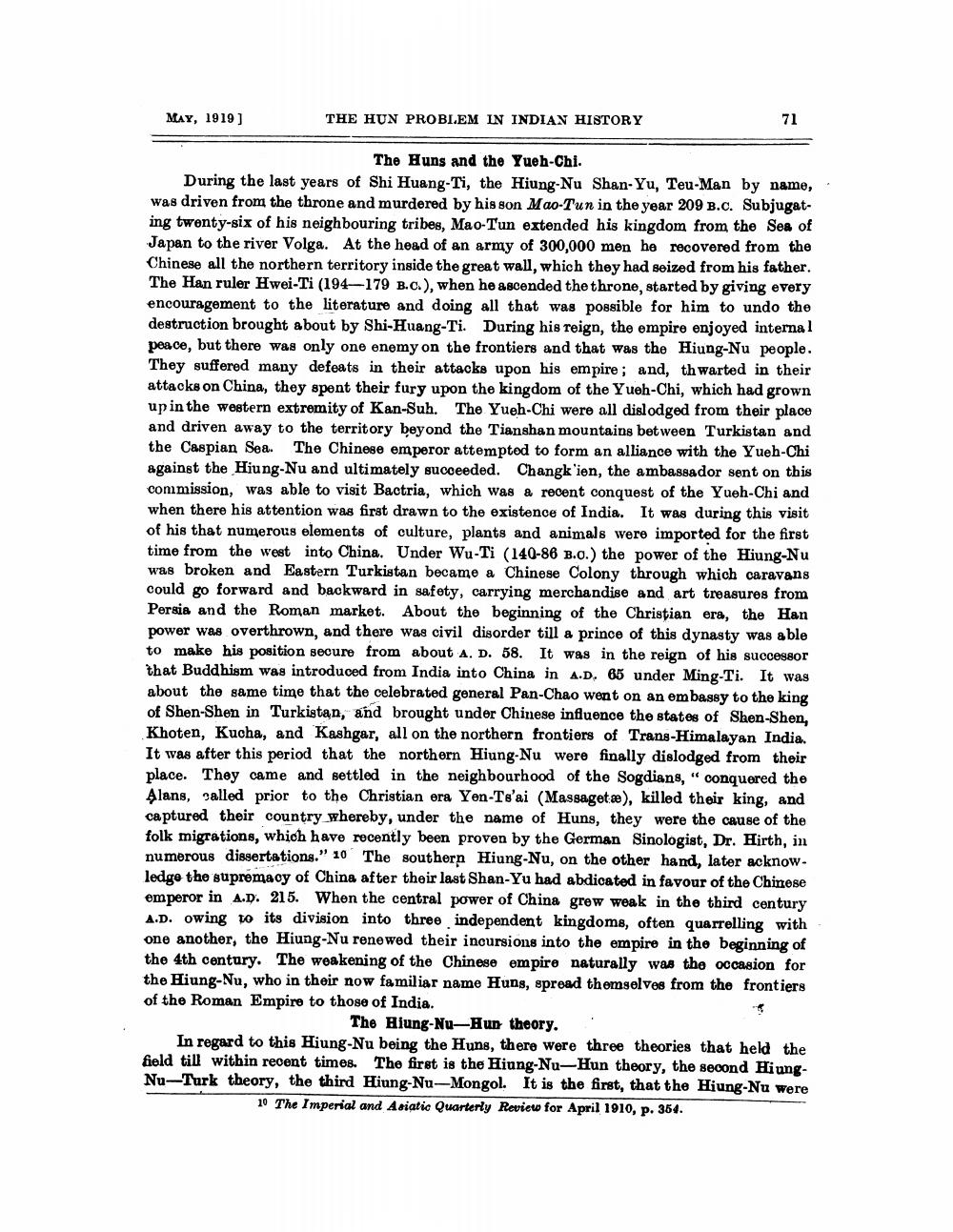________________
MAY, 1919)
THE HUN PROBLEM IN INDIAN HISTORY
71
The Huns and the Yueh-Chi. During the last years of Shi Huang-Ti, the Hiung-Nu Shan-Yu, Teu-Man by name, was driven from the throne and murdered by his son Mao-Tun in the year 209 B.C. Subjugating twenty-six of his neighbouring tribes, Mao-Tun extended his kingdom from the Sea of Japan to the river Volga. At the head of an army of 300,000 men he recovered from the Chinese all the northern territory inside the great wall, which they had seized from his father. The Han ruler Hwei-Ti (194—179 B.C.), when he ascended the throne, started by giving every encouragement to the literature and doing all that was possible for him to undo the destruction brought about by Shi-Huang-Ti. During his reign, the empire enjoyed internal peace, but there was only one enemy on the frontiers and that was the Hiung-Nu people. They suffered many defeats in their attacks upon his empire; and, thwarted in their attacks on China, they spent their fury upon the kingdom of the Yueh-Chi, which had grown up in the western extremity of Kan-Suh. The Yueh-Chi were all dislodged from their place and driven away to the territory beyond the Tianshan mountains between Turkistan and the Caspian Sea. The Chinese emperor attempted to form an alliance with the Yueh-Chi against the Hiung-Nu and ultimately succeeded. Changk'ien, the ambassador sent on this commission, was able to visit Bactria, which was a recent conquest of the Yueh-Chi and when there his attention was first drawn to the existence of India. It was during this visit of his that numerous elements of culture, plants and animals were imported for the first time from the west into China. Under Wu-Ti (140-86 B.o.) the power of the Hiung-Nu was broken and Eastern Turkistan became a Chinese Colony through which caravans could go forward and backward in safety, carrying merchandise and art treasures from Pergia and the Roman market. About the beginning of the Christian era, the Han power was overthrown, and there was civil disorder till a prince of this dynasty was able to make his position secure from about A. D. 58. It was in the reign of his successor that Buddhism was introduced from India into China in A.D. 65 under Ming-Ti. It was about the same time that the celebrated general Pan-Chao went on an embassy to the king of Shen-Shen in Turkistan, and brought under Chinese influence the states of Shen-Shen. Khoten, Kucha, and Kashgar, all on the northern frontiers of Trans-Himalayan India. It was after this period that the northern Hiung-Nu were finally dislodged from their place. They came and settled in the neighbourhood of the Sogdians, "conquered the Alans, called prior to the Christian era Yen-Ts'ai (Massagetæ), killed their king, and captured their country whereby, under the name of Huns, they were the cause of the folk migrations, which have recently been proven by the German Sinologist, Dr. Hirth, in numerous dissertations." 10 The southern Hiung-Nu, on the other hand, later acknowledge the supremacy of China after their last Shan-Yu had abdicated in favour of the Chinese emperor in a.d. 215. When the central power of China grew weak in the third century A.D. owing to its division into three independent kingdoms, often quarrelling with one another, the Hiung-Nu renewed their incursions into the empire in the beginning of the 4th century. The weakening of the Chinese empire naturally was the occasion for the Hiung-Nu, who in their now familiar name Hung, spread themselves from the frontiers of the Roman Empire to those of India.
The Biung-Nu-Hun theory. In regard to this Hiung-Nu being the Huns, there were three theories that held the field till within recent times. The first is the Hiung-Nu-Hun theory, the second HiungNu-Turk theory, the third Hiung-Nu-Mongol. It is the first, that the Hiung-Nu were
10 The Imperial and Asiatic Quarterly Review for April 1910, p. 364.




